Fatal Construction Injuries Reach Highest Levels Since 2011
Did you know that, in 2019, a worker died every 99 minutes from a work-related injury?
Many of these deaths took place among drivers, sales workers, and truck drivers (together, accounting for 1,005 fatal occupational injuries). 2019 also saw an alarming increase in fatalities among construction workers – where deaths jumped by 5% to 1,061.
The source of this data is the National Census of Fatal Occupational Injuries. While they might seem like just numbers that scare workers into following safety guidelines, the truth is that many can be prevented or avoided.
Here’s what you need to know about fatal injuries in construction, which are at their highest levels since 2011.
Occupational Fatalities Overview
What is an occupational fatality? It is simply a death that occurs while a person is at work or performing work-related tasks.
An occupational fatality can occur in any industry and while most are easily prevented, that’s not always the case. An occupational fatality might include any of the following:
- Falls
- Machine-related incident
- Motor vehicle accident
- Falling objects
- Electrocution
- Drowning
- Suicide
- Homicide
In this article, we’ll walk you through occupational fatality stats in the construction industry. These accidents have increased in number and changed in nature since 2011. The figures for the construction industry alone are shocking. What’s even more shocking is that many researchers believe these estimates undercount the true number of fatalities.
Many people believe that the number of workplace accidents and occupational fatalities is underreported. Most data from the International Labor Organization underestimates the true number of accidents and fatalities.
Most occupational fatalities are due to falls, falling objects, or similar accidents. But, there are many other ways to get injured on the job. They might not be the first things to come to mind, but workplace deaths due to suicides and unintentional overdoses can often be linked to workplace conditions.
In fact, deaths due to suicides (307 total) and unintentional overdoses (313) also contributed to the rise in occupational fatalities. Both increased slightly in 2019.
Other accidents that might fall into the occupational fatalities category might include the exposure to harmful substances or environments (which caused the deaths of 642 workers in 2019, the highest figure since 2011) and fatalities due to fires and explosions (the good news is that these deaths decreased by 14% in 2019).
Who is Responsible for Research, Regulation, and Reporting?
When it comes to researching, regulating, and reporting on occupational fatalities in the United States, the most significant regulatory organization for occupational injury control and prevention is the Occupational Safety and Health Administration, or OSHA.
OSHA was formed in the 1970s as an off-shoot agency of the United States Department of Labor under the auspices of the Occupational Safety and Health Act.
OSHA works to prevent occupational deaths and injuries by both creating and enforcing standards, addressing everything from employee training programs to safety equipment, recordkeeping, and the proper maintenance of the work environment.
When companies fail to comply with OSHA standards, it can result in rigorous inspections and legal action, including fines and citations. It can even cause an operation to be “red-flagged” and more serious legal ramifications can be sought.
Employers must keep records of occupational illnesses, fatalities, and injuries, with all fatalities reported within eight hours. A failure to do so can result in legal action.
In addition to federal OSHA regulations, 28 states have even more rigorous standards under state-mandated OSHA organizations.
In addition to OSHA, the National Institute for Occupational Safety and Health, as part of the Centers for Disease Control and Prevention and the United States Department of Health, also analyze workplace illness and injury data. The Fatality Assessment and Control Evaluation investigates occupational fatalities and offers recommendations to prevent and address these issues, too.
Finally, the Census of Fatal Occupational Injuries, along with numerous trade associations and unions and the National Safety Council, work to research, monitor, and address occupational fatalities.
Construction Fatalities Overview
On average, about three construction workers die of work-related injuries in the United States – every single day. Furthermore, one in five workplace fatalities tend to be construction-related, highlighting the need for safety awareness and proper protocols.
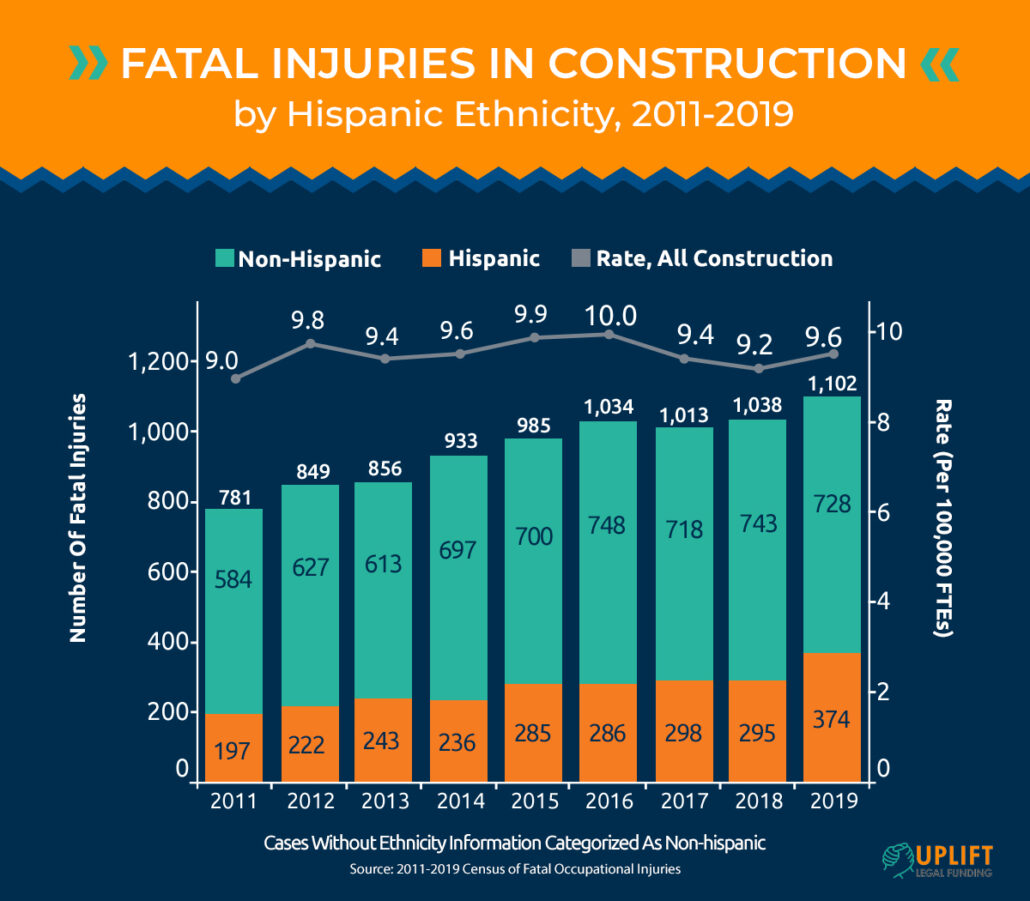
Construction is, by and large, one of the most dangerous industries in the United States. Why is construction such a dangerous occupation? There are several kinds of construction-related fatalities that fit the bill.
The most common types of fatalities that fall into this category are falls, electrocution, struck-by-an-object, and caught between objects.
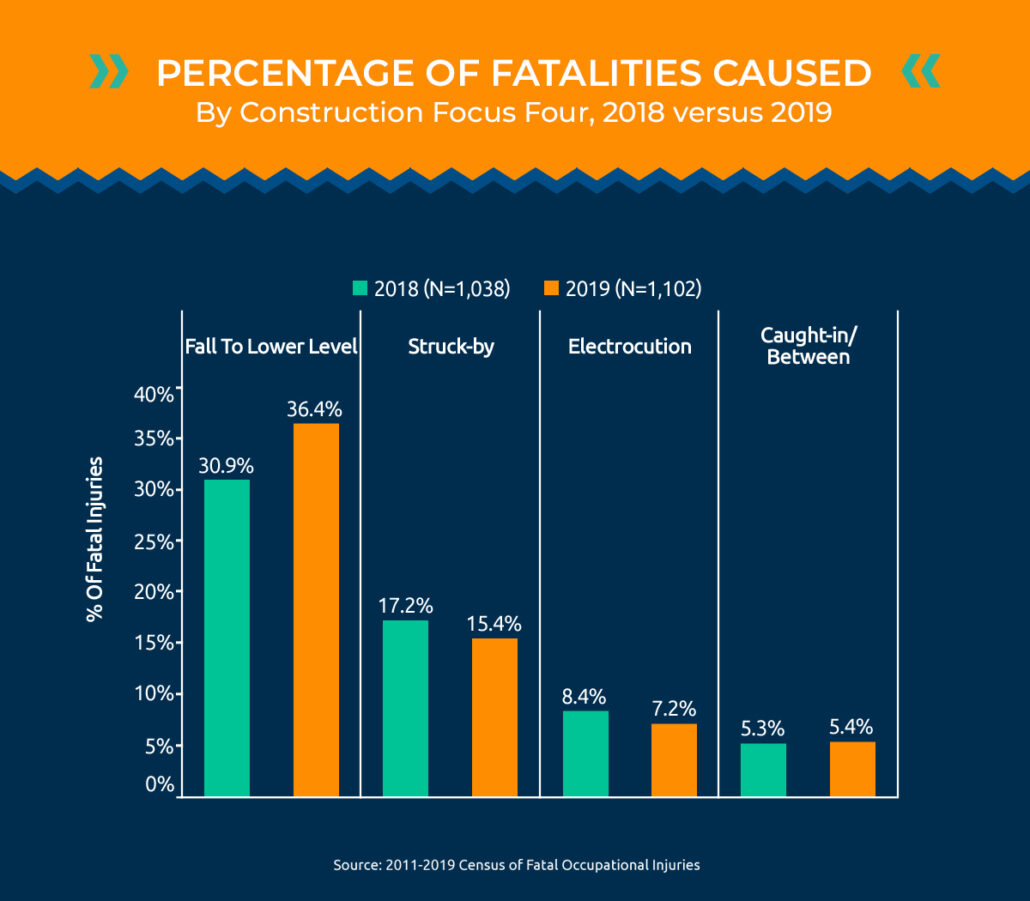
Trends
The number of construction workers killed on the job has reached its highest level in nearly a decade according to a recent report from the Center for Construction Training and Research.
This study highlighted the incidence of construction worker fatalities from 2011-2019, noting a 41.1% increase from the start of the study (2011) until 2019.
Falls represent about 46.9% of all fatalities, while struck by an object are representative of about 10.3% (these objects could be vehicles, masonry walls, or other falling or flying objects). Falls tend to be mostly from scaffolding, wall openings, unprotected sides, holes, and protruding steel bars. They can also be caused by the misuse of portable ladders.
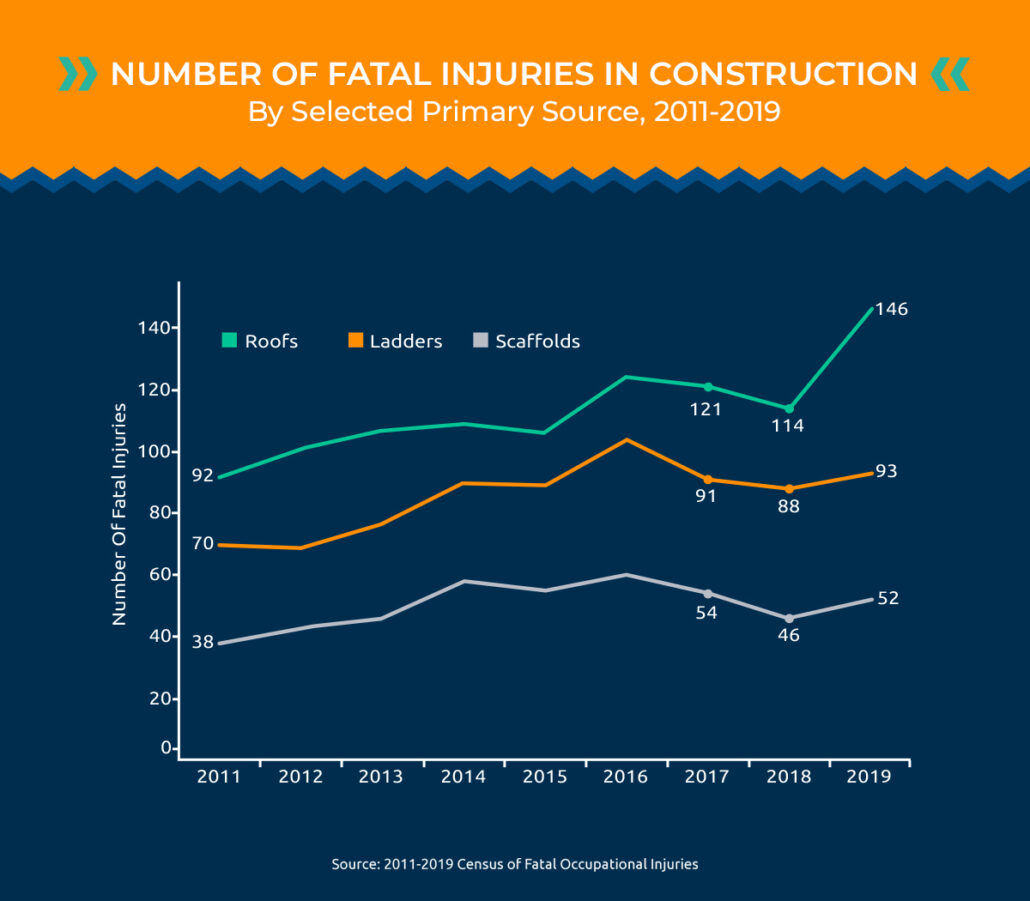
Roofs, however, represent the largest risk. They were the primary source of about 146 fatal injuries in 2019.
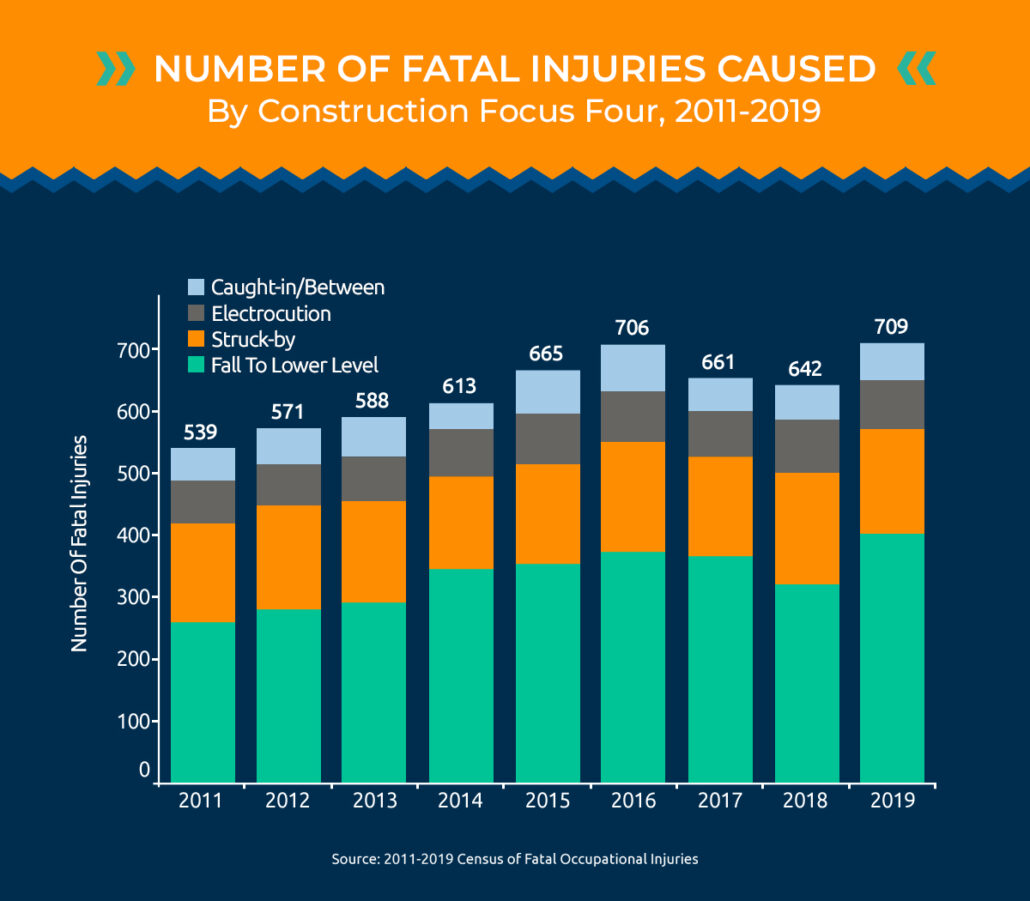
Electrocutions represent a smaller portion of workplace accidents at about 8.9% while caught between objects (usually the result of unsafe egresses and protective systems – or no protective systems to begin with) cause about 2.6% of injuries.
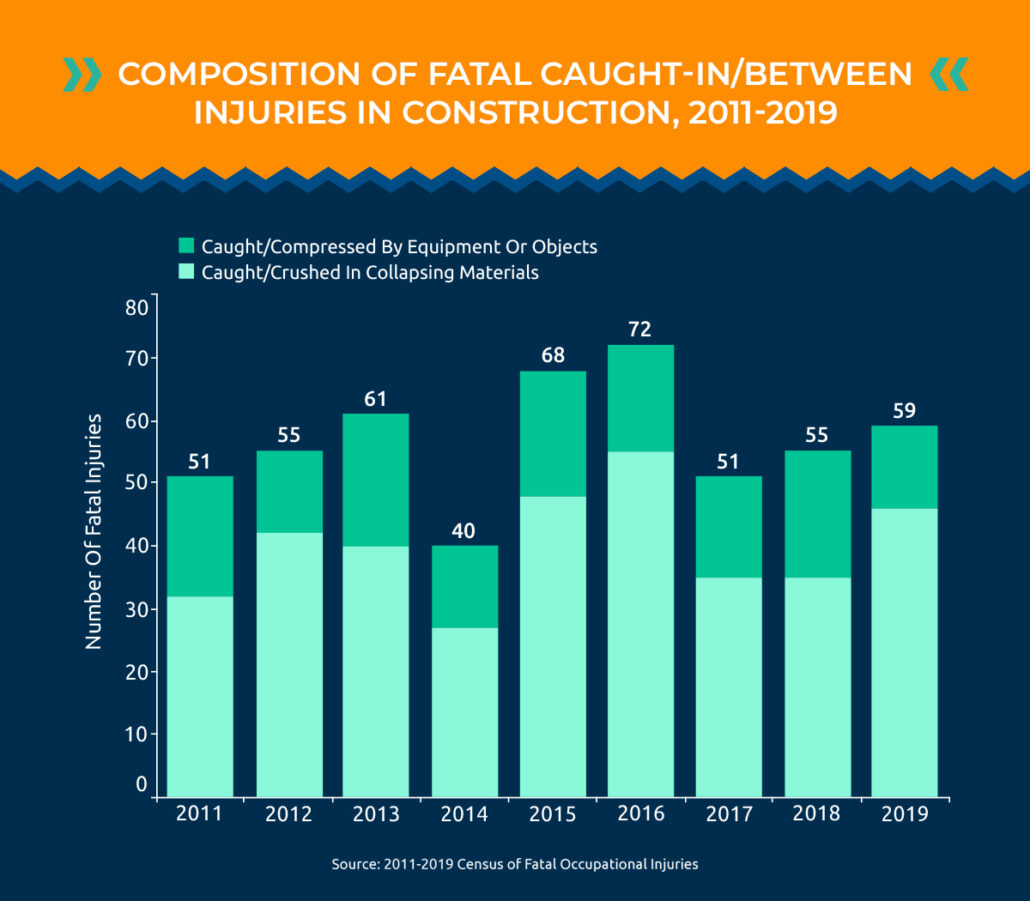
Interestingly, these trends are not equally represented among all states. Alaska has the highest rate of fatal occupational injuries – perhaps due to its large population of farming, fishing, and forestry workers – with a total of 14.1 fatal occupational injuries per 100,000. Connecticut had the lowest number, at 1.4 fatal occupational injuries per 100,000 full-time equivalent workers, according to the Bureau of Labor Statistics.
Key Findings
The most shocking discovery of this report, which aggregated data from the Census of Fatal Occupational Injuries, is that Hispanic workers tend to be most at risk when it comes to fatal workplace injuries in the construction industry.
Much of this can’t be explained by population alone. Although this group had a 55% rise in employment in this period, their injuries rose by 89.8%. The numbers simply don’t add up
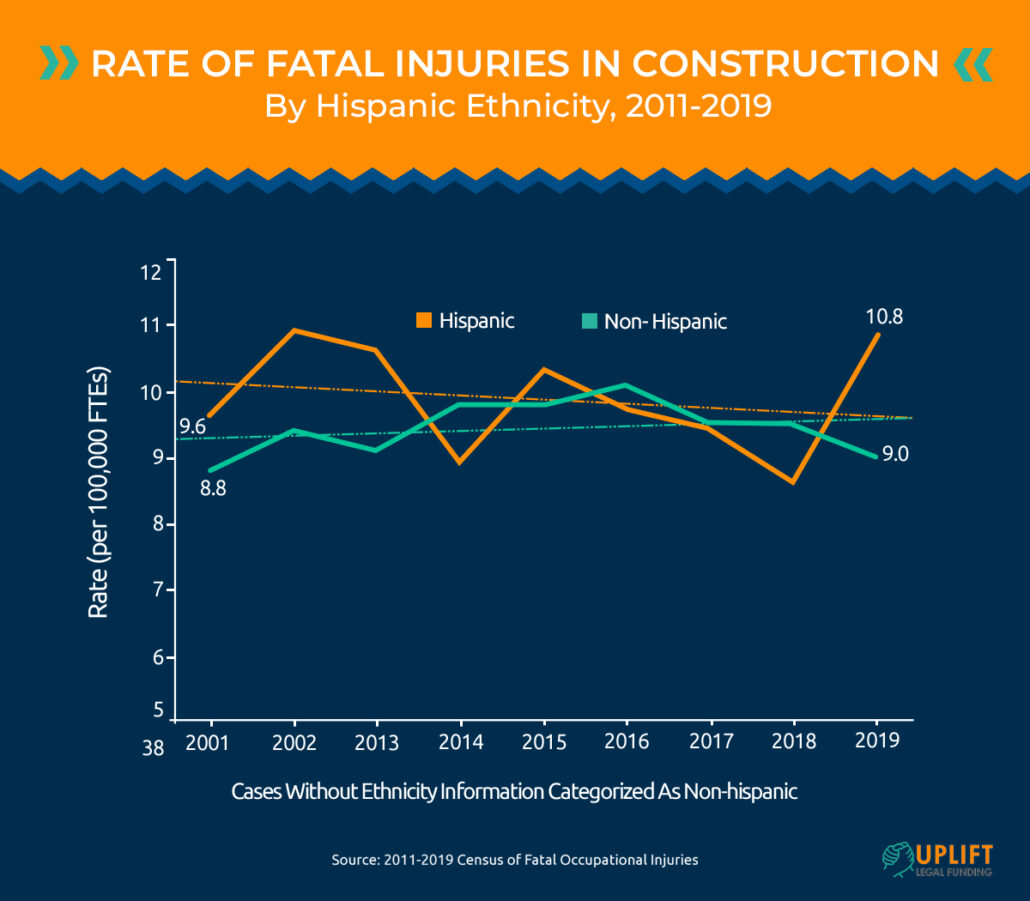
There was also a sharp increase in the number of older workers who suffered from construction-related workplace injuries. In fact, the 65+ age group saw the highest rate of fatal injuries at 22.0 per 100,000 full-time employees (this was more than double that of the next age group, 45-64).
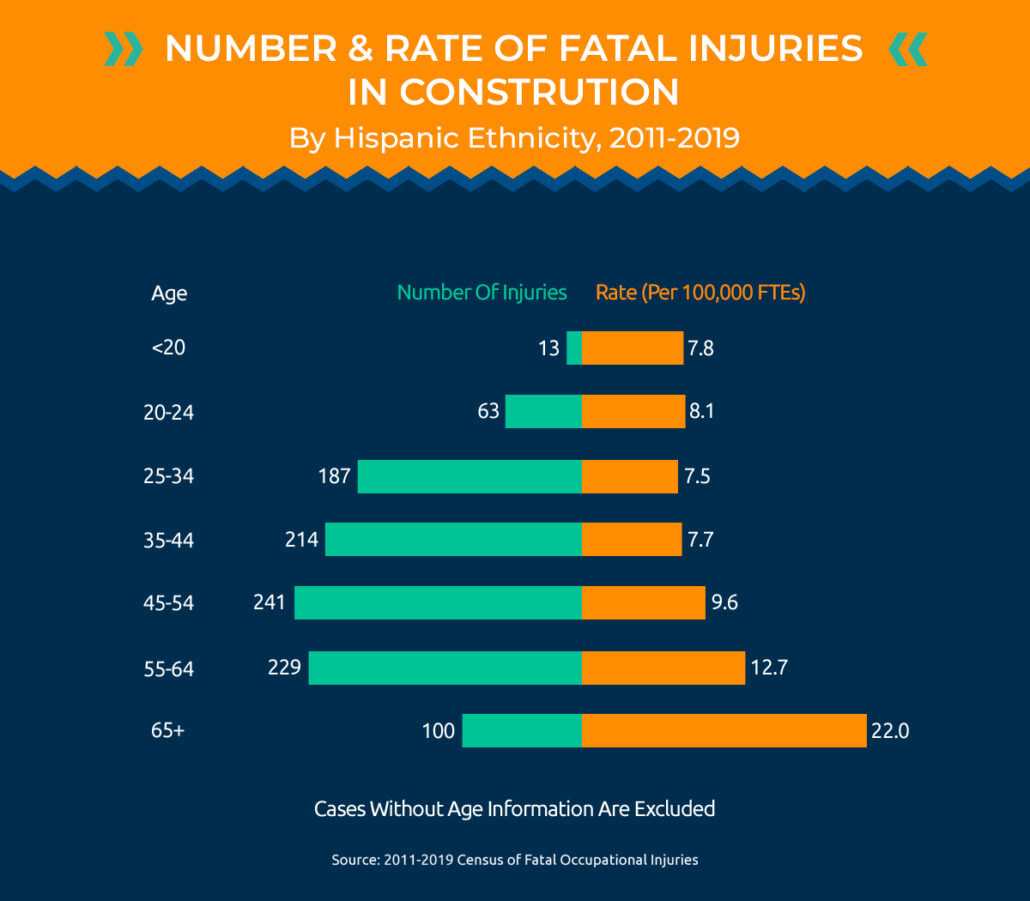
These trends and findings have urged the Center for Construction Research and Training to explore ways to mitigate deaths and injuries – in particular, this organization has urged employers to “proactively address fall hazards and to provide workers with sufficient protection” (like fall arrest systems).
Why Does This Matter?
If you’re reading this and wondering why it’s important, here’s some information that might encourage you to be a bit more aware of your working conditions.
The Numbers
Also known as workplace fatalities, occupational fatalities are often indicative of unsafe working conditions as well as the personal liabilities and risks faced by workers. 2018 alone saw a 2% increase in fatal workplace injuries, and while transportation incidents represented the majority of these incidents (about 46%), they were followed closely by violence as well as injuries by animals or other people.
Farming, fishing, and forestry tend to have the highest rate of workplace fatalities, followed by transportation and materials-moving occupations. However, construction and extraction workers aren’t far behind.
If you work in construction, there’s a good chance you know someone who was injured on the job. In fact, the workplace fatality rate for construction is about 12.2 deaths per 100,000 workers. That’s according to the U.S. Bureau of Labor STatistics’ Census of Fatal Occupational Injuries.
Accident Repercussions
The top ten most common OSHA-cited violations tend to be related to:
- Fall protection
- lockout/tagout
- Hazard communications
- Ladders
- Scaffolding
- Electrical and wiring methods
- Respiratory protection
- Machine guarding
- Powered industrial trucks
- Electrical general requirements
While it might sound like a simple oversight, failing to address one of these aspects of workplace safety can have major repercussions. Just because a construction company has not experienced any work-related fatalities, that doesn’t mean they are immune from the impacts.
Some potential accident repercussions include amputated limbs, disfigurement, scarring, back or neck injuries, blindness, deafness, spinal cord injury, brain injury, and more. These often lead to permanent or long-term impairment, preventing workers from returning to the job site and earning a living.
Legal Issues
Compensation for construction workers’ injuries can come either through a personal injury claim or a workers’ compensation claim.
Workers’ compensation claims are usually the quickest and easiest financial remedy for on-the-job injuries. Workers with a work-related injury can expect to receive almost guaranteed financial relief, paying lost wages and medical bills without having to file lawsuits or prove anyone was at fault.
The catch is that except in limited circumstances, the injured construction worker cannot sue their employer for being negligent and causing injury. This matters because some types of compensable losses such as pain and suffering are not available in an employee’s workers’ compensation claim.
Financial Costs
While it may sound a bit morbid to translate workplace fatalities, the loss of human life, into dollars and cents, the reality is that workplace injuries have a serious financial impact; The cost of work-related injuries in 2019 was $171 billion. This figure includes wage and productivity losses as well as medical expenses, administrative costs, and employers’ uninsured costs spent on the value of time lost by workers other than those with disabling injuries who are directly or indirectly involved in an injury. The total also includes damage to motor vehicles and fire losses incurred due to a workplace accident.
Who Is Affected?
If you think that workplace fatalities in the construction injury don’t affect you, think again. This is an issue that touches countless individuals.
However, some populations are disproportionately affected. Hispanic or Latino workers are more likely to suffer from workplace injuries or fatalities, particularly in construction. This is likely due to the fact that larger percentages of Hispanic and Latino adults work in high-risk jobs.
In fact, in 2014, nearly half (43.4%) of farming, fishing, and forestry workers along with a third (32.3%) of construction workers were of Hispanic or Latino descent. These tend to be extremely high-risk jobs that have the highest fatal injury rates in the country.
What Works?
While the statistics above can be shocking, the good news is that they are largely preventable. That’s why it’s so important to take measures to improve workplace safety.
We’ve already made major strides. Workplace safety improvements are regarded as one of the greatest public health achievements of the 1900s.
Some strategies that have been proven to prevent and reduce workplace fatalities and injuries, according to OSHA, include:
- Increasing safety precautions and regulatory oversight
- Inviting employees to continuously evaluate, identify, and reduce the incidence of dangerous conditions
- Offering and encouraging the use of high-quality and high-visibility apparel to workers in highway construction zones
- Offering and encouraging the use of personal protective equipment along with ladders and safe lifting techniques to reduce the likelihood of fatal falls
- Providing training materials for employers to use with their workers to prevent workplace injuries and fatalities
Accident Response and Mitigation
Knowing what to do when an accident happens is also important and is one of OSHA’s top priorities when it comes to preventing workplace fatalities. A serious injury can rapidly progress to a fatality if steps are not taken immediately when an accident occurs. Therefore, if you or someone you are working with suffers from an accident, it’s important to follow these steps immediately:
- Get medical attention
- Report and document the injury to the employer
- Gather contact information for witnesses
- Take photos of the injury, the location where the accident occurred, and any objects related to the injury
- Seek legal counsel and compensation
All too often, employers and employees alike avoid this last point – they might be afraid that seeking legal counsel will jeopardize their future. Employees might also fear that they are partly at fault and therefore don’t want to seek legal counsel. However, it’s always important to investigate any and all avenues to make sure everyone is protected and held accountable.
Ultimately, there’s no such thing as a standard construction accident case. The value of your case depends on many factors. Both the extent of your injuries and liability for the accident play a role. Therefore, it’s important to consult with an attorney if you’ve suffered from one of these accidents.
Risk Assessments and Safety Meetings
Before a project begins, it is the employers’ employee’s responsibility to inspect a construction site for hazards. Recognizing potential hazards and coming up with a proper safety plan can reduce the likelihood of an accident.
All workers should be made aware of those risks and updated frequently in regular safety meetings.
Some construction companies engage in what’s colloquially referred to as “Toolbox Talks.” These are short, informal discussions focused on specific safety issues to make sure that crews are reminded of risks and points of exposure on a job site.
Fall Prevention
Fall prevention is another key aspect that employers must identify to prevent fatal injuries in construction. Although falls aren’t the only cause of construction injuries and deaths, they represent a huge portion of all accidents and warrant a specially-tailored response.
Falls to a lower level were largely responsible for the increase in fatalities in 2019. Companies must continue to proactively address fall hazards and offer sufficient protection.
A fall to a lower level is an injury that is caused by the impact between a lower surface and a falling person, such as a fall from a collapsing structure or even into a body of water.
Employers should ensure that safety training, especially related to falls, reaches all members of the employed population, especially Hispanic workers (including young and new immigrants). This training must meet the cultural and bilingual needs of all those involved – particularly the Hispanic population.
Also, retraining and work redesign should be conducted on an as-needed basis to improve the safety of older workers in particular. That way, their talents can continue to benefit the construction industry with a reduced risk of on-the-job accidents.
Equipment Maintenance Checks
Equipment maintenance checks are also integral in the construction industry. The kind of equipment that is used on the average construction site far supersedes our natural abilities as humans. Heavy machinery has tremendous power and can dramatically increase the productivity of a worksite – but it can also be dangerous.
From trucks to cranes, employees and employers must conduct regular maintenance checks to reduce the chance of malfunction.
Proper Training is Key
Proper training is key in preventing and addressing occupational fatalities. Worker safety is not just the responsibility of the worker, but also the employer.
Therefore, it’s vital that employers train all employees in safety procedures. This is not a one-and-done solution. Ongoing training is important to ensure that all protocols are updated, visible, and understood.
Employers should consult the latest standards and advice published by OSHA as well as other industry-specific guidance. The Haddon Matrix is another tool that helps assess the risks leading up to, during, and after a death. This system helps prevent future accidents of a similar nature.
Conclusion
So who is responsible for construction accidents? Everyone.
Workplace accidents can happen regardless of the situation, location, or employer. These accidents can mean being out of work for weeks, months, or years – or they can result in death.
It is the job of a supervisor, the employer, and the worker himself to maintain safe working conditions on construction sites.
Uplift Legal Funding and Construction Accident Lawsuit Loans
Uplift Legal Funding provides non-recourse legal funding loans for various types of personal injury claims. We specialize in loans on construction accident lawsuits. To learn more, give us a call at (800) 385-3660 or apply online.
Pingback: 5 Ways for Construction Workers to Stay Safe - Business Partner Magazine